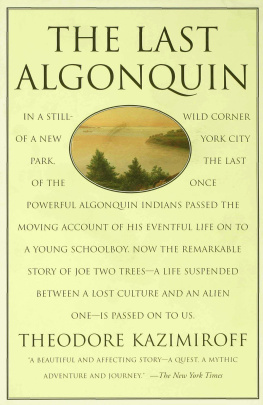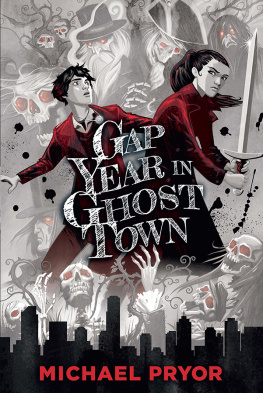The Last Algonquin
The Last Algonquin
Theodore L. Kazimiroff

Copyright 1982 by Theodore L. Kazimiroff
All rights reserved. No part of this book may be reproduced or transmitted in any form or by any means, electronic or mechanical, including photocopying, recording, or by any information storage and retrieval system, without permission in writing from the Publisher.
First published in the United States of America in 1982 by Walker Publishing Company, Inc.; this paperback edition published in 1997.
Published simultaneously in Canada by Thomas Allen & Son
Canada, Limited, Markham, Ontario.
Library of Congress Cataloging-in-Publication Data
Kazimiroff, Theodore L.
The Last Algonquin.
Includes index.
1. Two Trees, Joe. 2. Algonquian Indians
Biography. I. Title
E99.A35T964 1982 970.004'97 [B] 81-69711
AACR2
eISBN 978-0-802-71952-2
Printed in the United States of America
8 10 9 7
Contents
The spelling of the word "Algonquin" used throughout this book was chosen because it is the most familiar to the general reader. The name has many spellings, since all are transcriptions of a spoken word: "Algonkin," "Algonkan," "Algonquian" and "Algonkian." Various versions have prevailed for a period and then died away. My own personal choice would have been "Algonkian," which is my interpretation of the word as it was spoken to my father, and many years later, to me. However, it was felt that this form might puzzle many readers, and so we have elected to use the one that is the most readily recognizable today.

This map shows The Bronx as it was when the Indians left. Very few "improvements"been made yet. The great land-moving projects and landfill ventures of the 1930s and1940s hadn't happened. Hunter Island was still an island. The Bronx was not incorporatedas a county of New York City until 1914.
Hunter Island
Twin Island
Two Trees Island
Hart Island
Mishow
Saxon Stone
Vagabond Bay
Site of Pell land purchase in 1654
Revolutionary War landing by British General Sir William Howe
Aquehonga, sold to Jonas Bronk in 1641
Snak-a-pins
Sewanhacky (Long Island)
Manhattan Island
Hell Gate (Monatun)
Joe Two Trees' probable route from Hunter Island to New York City
Joe's river route back to Hunter Island
Dr. Theodore Kazimiroff s boyhood home
THE best description I can think of for Ted Kazimiroff, Sr., whom I knew for at least forty-five years, is that of an over-engined dynamo. I met him first on Hunter Island in Pelham Bay Park, in New York City's Bronx, by chance the locale of this, his son's book. This was in the 1930s, well before the start of World War II. The shore islands of Pelham Bay Park were then still in existence, and I was exploring for Indian artifacts in an area that looked much as it must have to Joe Two Trees.
Later, Ted invited me to his home. I admired his artifacts, which he had surface-collected on the beaches, and was shown the amazing family garden, where were planted a whole variety of trees, causing me to wonder how in such a confined space all of them could grow and thrive.
Our paths crossed intermittently. Ted had graduated college and gone on to dental school at New York University when I met him again. This time I was in a dentist's chair at the school and Ted was supervising beginning dental students. I was then attending college myself. Much later in life, I became one of Ted's many patient patients, often eavesdropping unabashedly on the telephone calls from his construction-men "scouts" and numerous others who wanted to talk to Ted about practically everything under the sun. And he appeared to have an educated opinion about many things.
I took several trips with Ted. After a session at his dentist's chair, we would have lunch at the old mill in Bronx Park at the New York Botanical Garden. From there we would go around to see a little Fordham gneiss rock shelter in the woods, where Ted had made an excavation for Indian artifacts years before. Once we stopped on the way by the side of the Bronx River to inspect and photograph a small boulder on which was pecked out the life-sized likeness of a turtle. This may well have been the mark of the Turtle Clan in the story of Joe Two Trees.
On another excursion, we went to the eastern shore of the Harlem River below Fordham Road, where we collected nonnative flint which must have come over as ballast in the holds of English sailing ships probably about 250 years ago. Ted, always the instructor, filled me with the lore of the neighborhood, the history of which he must have absorbed through the very pores of his skin from many years of study and investigation.
His skills and knowledge were such that in 1965 we tried to get funds to enable Ted to join Columbia University's dig in Iraq, to study the dentition of some early Neolithic skeletons we had found there, but sadly, his part of the project never materialized.
One of Ted's numerous activities was that of official historian of Bronx County, an unsalaried position in which he served from 1953 until his death in 1980. He was president of the Kings bridge Historical Society, and the founder, in the 1960s, of the Bronx Historical Society. In this latter capacity he saved the Varian House, dating from the Revolutionary War, from demolition, and he identified a sunken forest off the shores of Pelham Bay Park that has been dated back some 3,000 years. He was a fellow of and consultant to the New York Zoological Society and the New York Botanical Garden, where he knew the scientists there on a first-name basis and communicated with them regularly.
Ted was an ecologist before the word became popular, and a conservationist well before it became fashionable and newsworthy to be one. He sparked the establishment of the wildlife preserve in the Pelham Bay area, the Thomas Pell Wildlife Sanctuary. He led memorable tours along the Bronx River in Bronx Park, imparting his intimate knowledge of that region's natural history to a grateful public. And perhaps the biggest disappointment of his life was the failure of his struggle against what he called "the monstrous rape of Pelham Bay Park"the dumping there of what the city euphemistically called "landfill," but what is simply garbage.
As everyone who knew him can corroborate, Ted's basement and study were (and still are) filled to overflowing with more than a million artifacts, which he had hoped to find time to write about one day. Indeed, were it not for Ted Kazimiroff, archaeologists of today would not have even a fraction of the data on the New York City area that now exists because he had the skill and determination to salvage it.
Ted's profession as a dentist brought him into contact with many personalities from all walks of life and his friends are legion. But I think Ted missed his calling. With his natural talent for field research and as a teacher, he should have been on the faculty of one of our universities. He and I had long planned to write a book together on the archaeology of New York City. That was not to be. But Ted's son has created in these pages another book which in a very real sense is the senior Kazimiroff s. I am grateful that the son has so ably captured the spirit of my friend, his father.
Ralph S. Solecki
September, 1981
EACH of these individuals gave me some special thing. Each added to this book in his own way. I thank them all as valued friends.
Next page










